Strategic Management Analysis of IKEA: A Comprehensive Report
VerifiedAdded on 2019/12/04
|18
|5584
|186
Report
AI Summary
This report provides a detailed analysis of IKEA's strategic management. It begins by evaluating IKEA's strategic capabilities through value chain analysis, examining its primary and support activities. The report then assesses IKEA's external environment using Porter's Five Forces model, identifying the threats of new entrants and substitutes. It also addresses the major ethical and social responsibility issues IKEA faces, utilizing PESTEL analysis to consider political, economic, social, technological, environmental, and legal factors. The report proposes a range of alternative future strategies for IKEA, including market penetration, product development, market development, and diversification, based on Ansoff's matrix and Porter's generic strategies, such as differentiation. The report concludes by discussing intended and emergent approaches to strategy formation within IKEA.
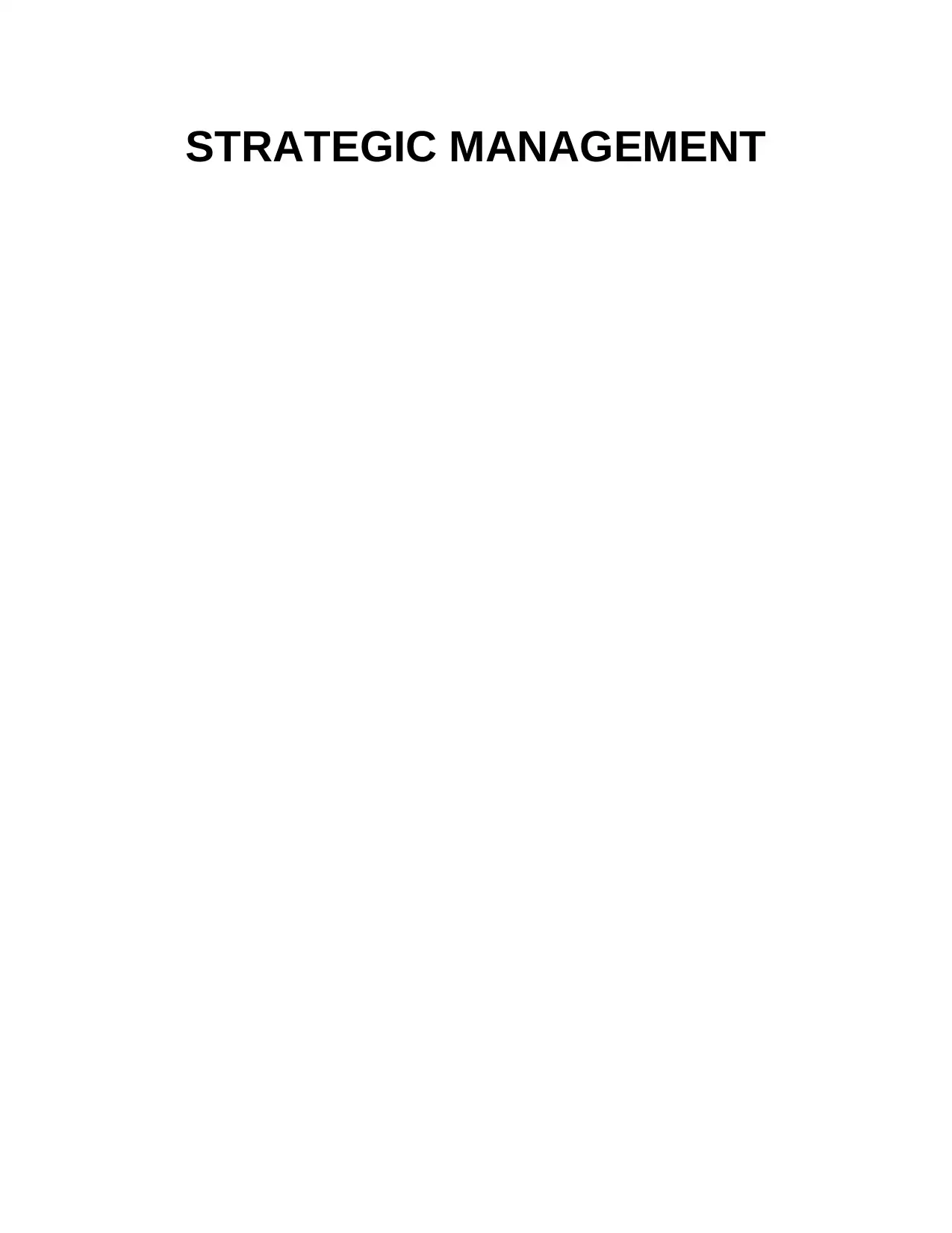
STRATEGIC MANAGEMENT
Paraphrase This Document
Need a fresh take? Get an instant paraphrase of this document with our AI Paraphraser

TABLE OF CONTENTS
INTRODUCTION..............................................................................................................1
TASK 1.............................................................................................................................1
Evaluating the strategic capability of IKEA..............................................................1
Evaluating the environment facing IKEA..................................................................3
Identifying the major issues relating to ethics and social responsibility which IKEA is
facing....................................................................................................................... 5
TASK 2.............................................................................................................................6
Proposing a range of alternative future strategies for IKEA.....................................6
Justifying the above strategies.................................................................................8
TASK 3.............................................................................................................................9
Intended and emergent approaches to strategy formation in IKEA.........................9
CONCLUSION............................................................................................................... 10
REFERENCES...............................................................................................................11
APPENDIX .................................................................................................................... 13
Appendix 1: Value chain analysis..........................................................................13
Appendix 2 Porter five forces model .....................................................................13
Appendix 3 Major ethical and social issues ..........................................................14
Appendix 4 Porter generic matrix ..........................................................................15
Appendix 5: Justifying the strategies ....................................................................15
INTRODUCTION..............................................................................................................1
TASK 1.............................................................................................................................1
Evaluating the strategic capability of IKEA..............................................................1
Evaluating the environment facing IKEA..................................................................3
Identifying the major issues relating to ethics and social responsibility which IKEA is
facing....................................................................................................................... 5
TASK 2.............................................................................................................................6
Proposing a range of alternative future strategies for IKEA.....................................6
Justifying the above strategies.................................................................................8
TASK 3.............................................................................................................................9
Intended and emergent approaches to strategy formation in IKEA.........................9
CONCLUSION............................................................................................................... 10
REFERENCES...............................................................................................................11
APPENDIX .................................................................................................................... 13
Appendix 1: Value chain analysis..........................................................................13
Appendix 2 Porter five forces model .....................................................................13
Appendix 3 Major ethical and social issues ..........................................................14
Appendix 4 Porter generic matrix ..........................................................................15
Appendix 5: Justifying the strategies ....................................................................15
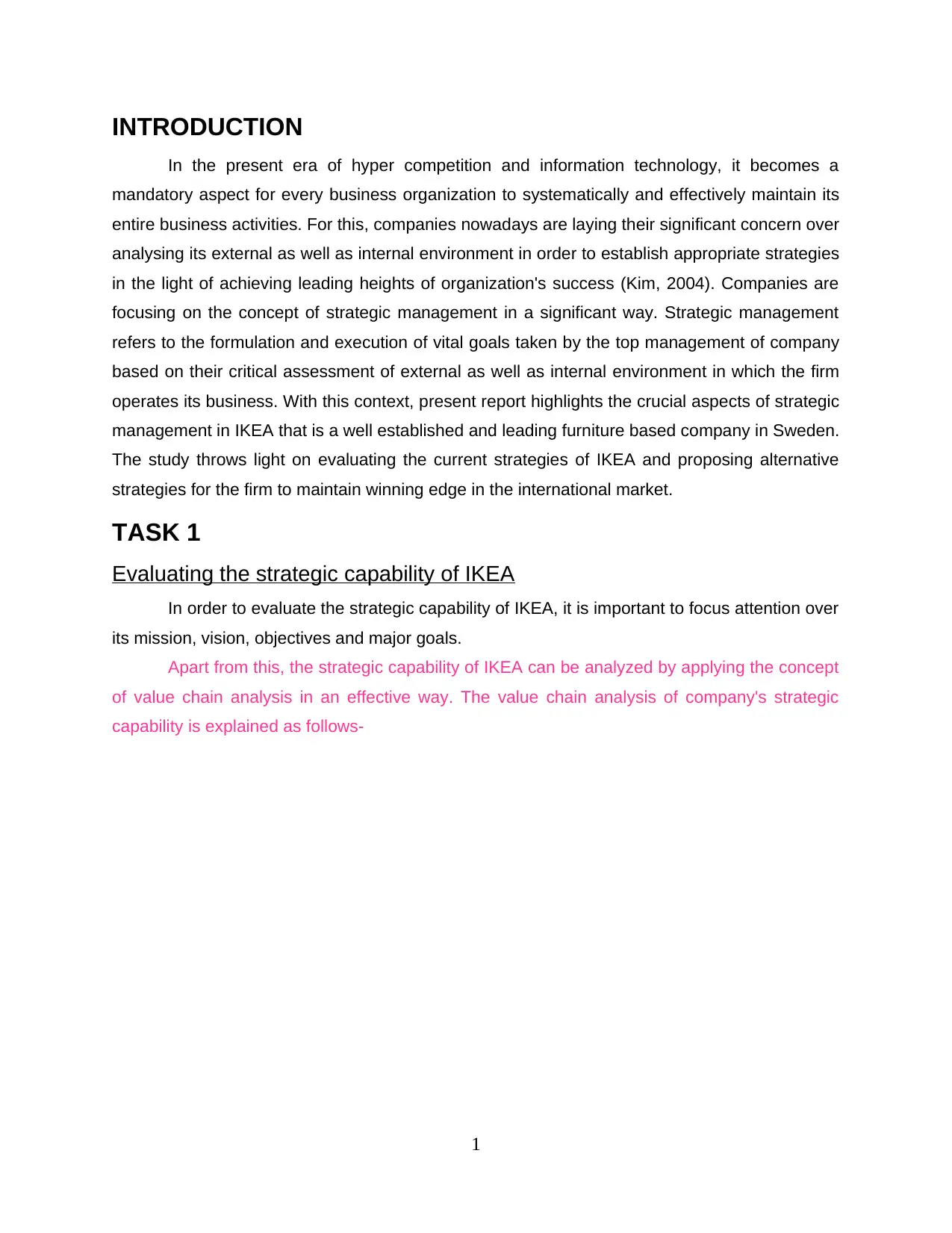
INTRODUCTION
In the present era of hyper competition and information technology, it becomes a
mandatory aspect for every business organization to systematically and effectively maintain its
entire business activities. For this, companies nowadays are laying their significant concern over
analysing its external as well as internal environment in order to establish appropriate strategies
in the light of achieving leading heights of organization's success (Kim, 2004). Companies are
focusing on the concept of strategic management in a significant way. Strategic management
refers to the formulation and execution of vital goals taken by the top management of company
based on their critical assessment of external as well as internal environment in which the firm
operates its business. With this context, present report highlights the crucial aspects of strategic
management in IKEA that is a well established and leading furniture based company in Sweden.
The study throws light on evaluating the current strategies of IKEA and proposing alternative
strategies for the firm to maintain winning edge in the international market.
TASK 1
Evaluating the strategic capability of IKEA
In order to evaluate the strategic capability of IKEA, it is important to focus attention over
its mission, vision, objectives and major goals.
Apart from this, the strategic capability of IKEA can be analyzed by applying the concept
of value chain analysis in an effective way. The value chain analysis of company's strategic
capability is explained as follows-
1
In the present era of hyper competition and information technology, it becomes a
mandatory aspect for every business organization to systematically and effectively maintain its
entire business activities. For this, companies nowadays are laying their significant concern over
analysing its external as well as internal environment in order to establish appropriate strategies
in the light of achieving leading heights of organization's success (Kim, 2004). Companies are
focusing on the concept of strategic management in a significant way. Strategic management
refers to the formulation and execution of vital goals taken by the top management of company
based on their critical assessment of external as well as internal environment in which the firm
operates its business. With this context, present report highlights the crucial aspects of strategic
management in IKEA that is a well established and leading furniture based company in Sweden.
The study throws light on evaluating the current strategies of IKEA and proposing alternative
strategies for the firm to maintain winning edge in the international market.
TASK 1
Evaluating the strategic capability of IKEA
In order to evaluate the strategic capability of IKEA, it is important to focus attention over
its mission, vision, objectives and major goals.
Apart from this, the strategic capability of IKEA can be analyzed by applying the concept
of value chain analysis in an effective way. The value chain analysis of company's strategic
capability is explained as follows-
1
⊘ This is a preview!⊘
Do you want full access?
Subscribe today to unlock all pages.

Trusted by 1+ million students worldwide

Illustration 1: Porter's value chain analysis
(Source: Rosen, 2006)
Using the value chain analysis, IKEA categorizes its set of business activities in two
segments which are as follows-
PRIMARY ACTIVITIES
Activity Implementation by IKEA
Inbound Logistics Distributes the product from around 42 distribution centres to
the retail stores.
Around 1000 suppliers manufacture 10,000 items of product
line.
Outbound Logistics Appropriate method for target consumers to transport their
furniture items by themselves.
Operations Operates its business in more than 50 countries and has 208
operated stores in 25 countries.
Marketing and Sales Target market consists of middle and upper middle class with
2
(Source: Rosen, 2006)
Using the value chain analysis, IKEA categorizes its set of business activities in two
segments which are as follows-
PRIMARY ACTIVITIES
Activity Implementation by IKEA
Inbound Logistics Distributes the product from around 42 distribution centres to
the retail stores.
Around 1000 suppliers manufacture 10,000 items of product
line.
Outbound Logistics Appropriate method for target consumers to transport their
furniture items by themselves.
Operations Operates its business in more than 50 countries and has 208
operated stores in 25 countries.
Marketing and Sales Target market consists of middle and upper middle class with
2
Paraphrase This Document
Need a fresh take? Get an instant paraphrase of this document with our AI Paraphraser
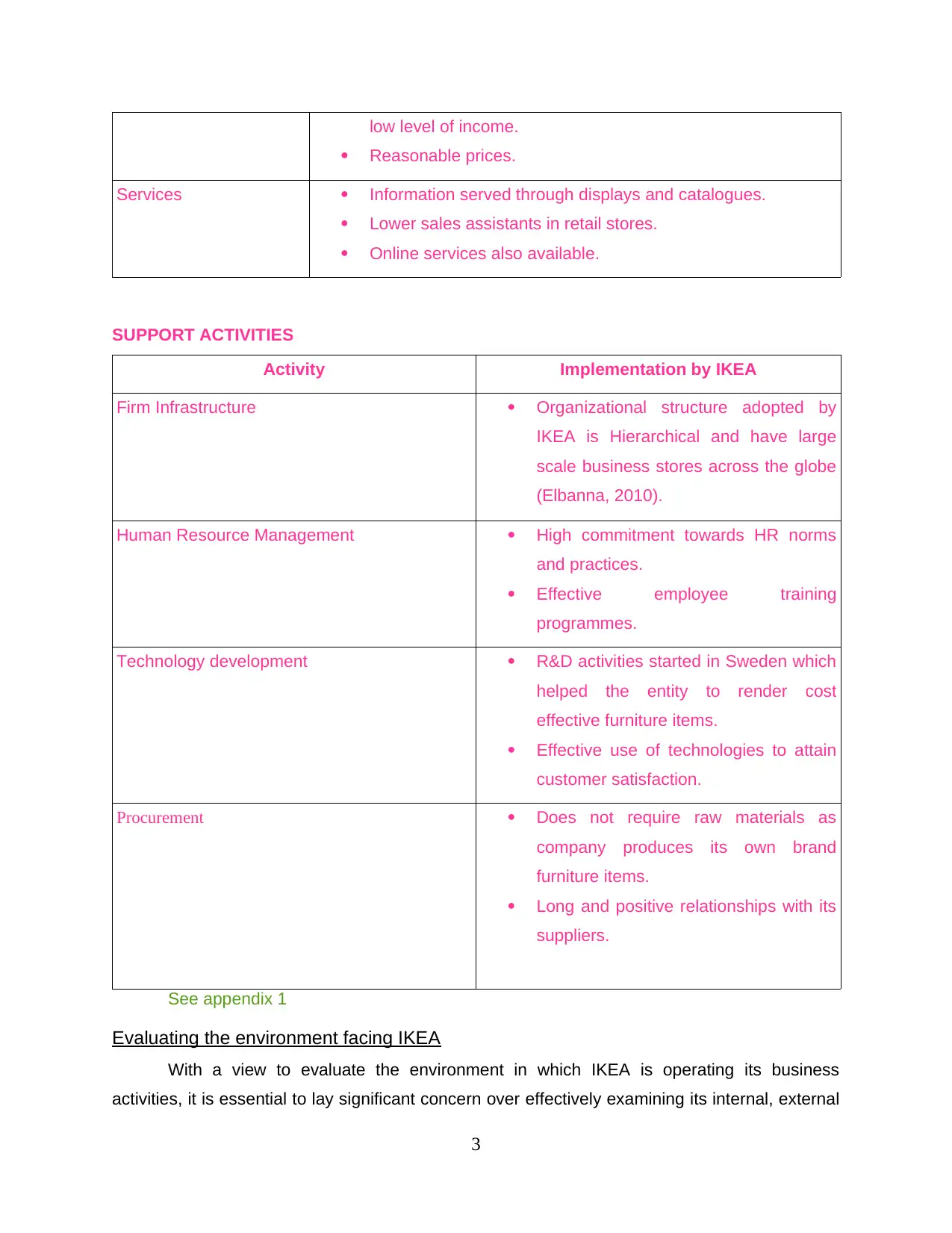
low level of income.
Reasonable prices.
Services Information served through displays and catalogues.
Lower sales assistants in retail stores.
Online services also available.
SUPPORT ACTIVITIES
Activity Implementation by IKEA
Firm Infrastructure Organizational structure adopted by
IKEA is Hierarchical and have large
scale business stores across the globe
(Elbanna, 2010).
Human Resource Management High commitment towards HR norms
and practices.
Effective employee training
programmes.
Technology development R&D activities started in Sweden which
helped the entity to render cost
effective furniture items.
Effective use of technologies to attain
customer satisfaction.
Procurement Does not require raw materials as
company produces its own brand
furniture items.
Long and positive relationships with its
suppliers.
See appendix 1
Evaluating the environment facing IKEA
With a view to evaluate the environment in which IKEA is operating its business
activities, it is essential to lay significant concern over effectively examining its internal, external
3
Reasonable prices.
Services Information served through displays and catalogues.
Lower sales assistants in retail stores.
Online services also available.
SUPPORT ACTIVITIES
Activity Implementation by IKEA
Firm Infrastructure Organizational structure adopted by
IKEA is Hierarchical and have large
scale business stores across the globe
(Elbanna, 2010).
Human Resource Management High commitment towards HR norms
and practices.
Effective employee training
programmes.
Technology development R&D activities started in Sweden which
helped the entity to render cost
effective furniture items.
Effective use of technologies to attain
customer satisfaction.
Procurement Does not require raw materials as
company produces its own brand
furniture items.
Long and positive relationships with its
suppliers.
See appendix 1
Evaluating the environment facing IKEA
With a view to evaluate the environment in which IKEA is operating its business
activities, it is essential to lay significant concern over effectively examining its internal, external
3
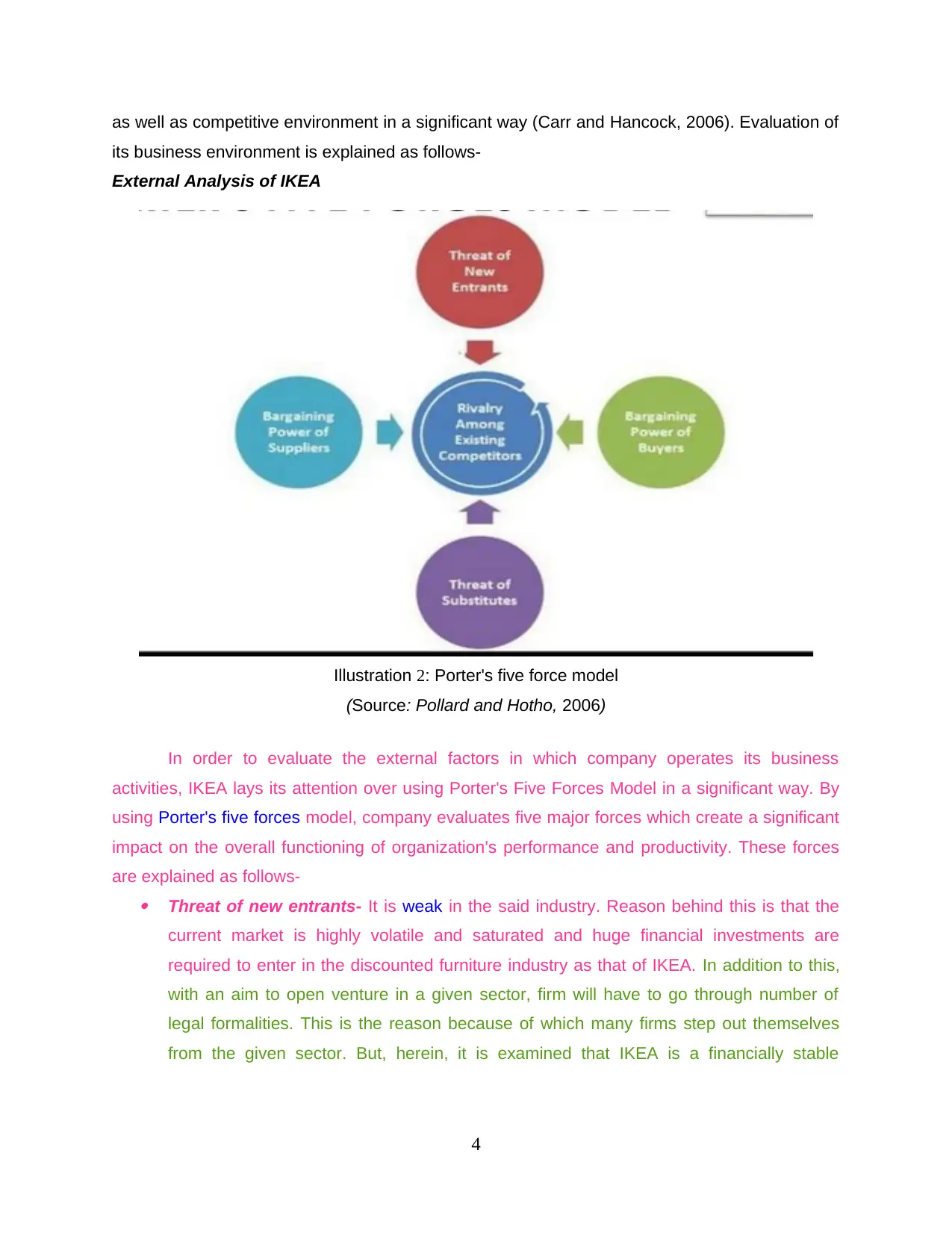
as well as competitive environment in a significant way (Carr and Hancock, 2006). Evaluation of
its business environment is explained as follows-
External Analysis of IKEA
In order to evaluate the external factors in which company operates its business
activities, IKEA lays its attention over using Porter's Five Forces Model in a significant way. By
using Porter's five forces model, company evaluates five major forces which create a significant
impact on the overall functioning of organization's performance and productivity. These forces
are explained as follows- Threat of new entrants- It is weak in the said industry. Reason behind this is that the
current market is highly volatile and saturated and huge financial investments are
required to enter in the discounted furniture industry as that of IKEA. In addition to this,
with an aim to open venture in a given sector, firm will have to go through number of
legal formalities. This is the reason because of which many firms step out themselves
from the given sector. But, herein, it is examined that IKEA is a financially stable
4
Illustration 2: Porter's five force model
(Source: Pollard and Hotho, 2006)
its business environment is explained as follows-
External Analysis of IKEA
In order to evaluate the external factors in which company operates its business
activities, IKEA lays its attention over using Porter's Five Forces Model in a significant way. By
using Porter's five forces model, company evaluates five major forces which create a significant
impact on the overall functioning of organization's performance and productivity. These forces
are explained as follows- Threat of new entrants- It is weak in the said industry. Reason behind this is that the
current market is highly volatile and saturated and huge financial investments are
required to enter in the discounted furniture industry as that of IKEA. In addition to this,
with an aim to open venture in a given sector, firm will have to go through number of
legal formalities. This is the reason because of which many firms step out themselves
from the given sector. But, herein, it is examined that IKEA is a financially stable
4
Illustration 2: Porter's five force model
(Source: Pollard and Hotho, 2006)
⊘ This is a preview!⊘
Do you want full access?
Subscribe today to unlock all pages.

Trusted by 1+ million students worldwide
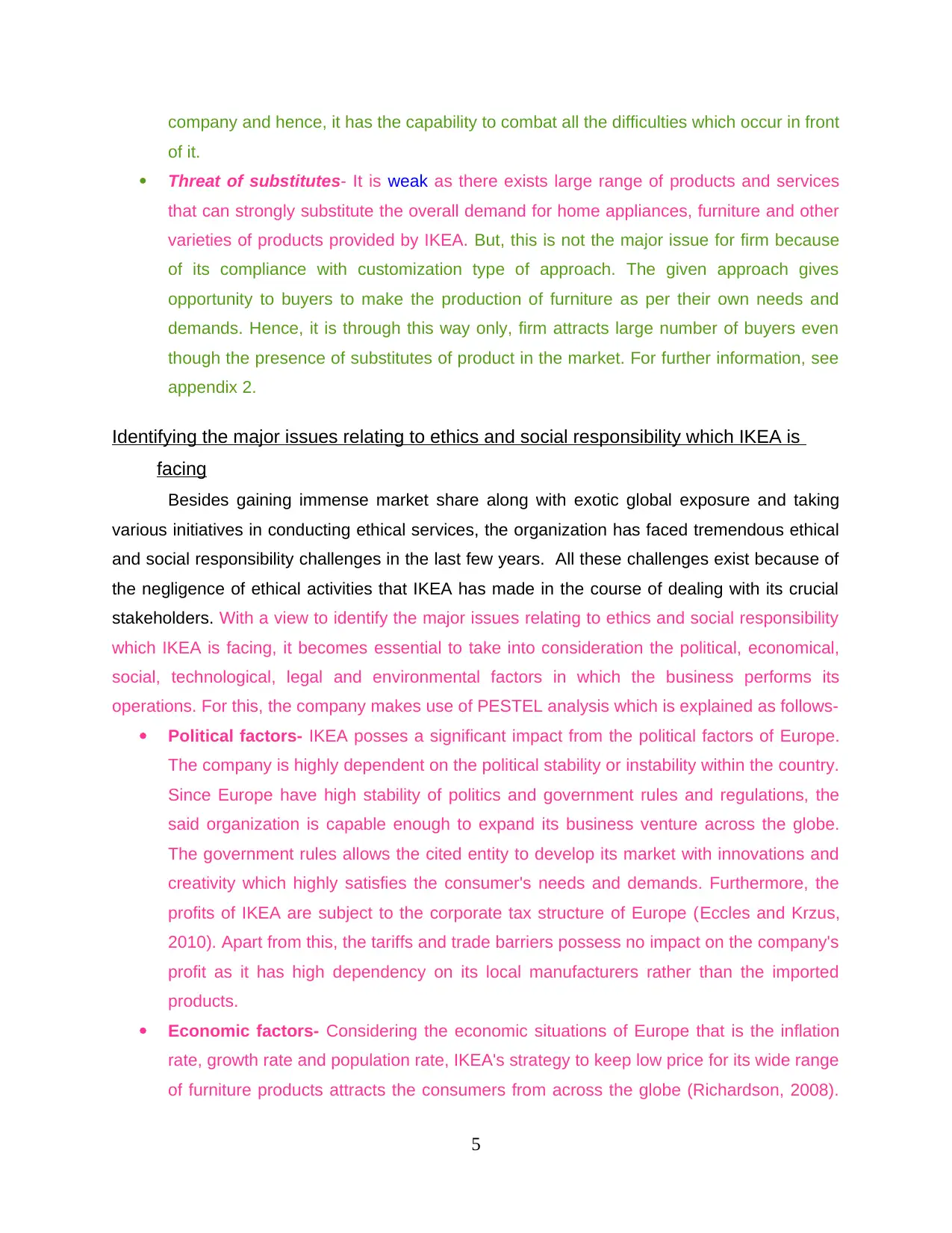
company and hence, it has the capability to combat all the difficulties which occur in front
of it.
Threat of substitutes- It is weak as there exists large range of products and services
that can strongly substitute the overall demand for home appliances, furniture and other
varieties of products provided by IKEA. But, this is not the major issue for firm because
of its compliance with customization type of approach. The given approach gives
opportunity to buyers to make the production of furniture as per their own needs and
demands. Hence, it is through this way only, firm attracts large number of buyers even
though the presence of substitutes of product in the market. For further information, see
appendix 2.
Identifying the major issues relating to ethics and social responsibility which IKEA is
facing
Besides gaining immense market share along with exotic global exposure and taking
various initiatives in conducting ethical services, the organization has faced tremendous ethical
and social responsibility challenges in the last few years. All these challenges exist because of
the negligence of ethical activities that IKEA has made in the course of dealing with its crucial
stakeholders. With a view to identify the major issues relating to ethics and social responsibility
which IKEA is facing, it becomes essential to take into consideration the political, economical,
social, technological, legal and environmental factors in which the business performs its
operations. For this, the company makes use of PESTEL analysis which is explained as follows-
Political factors- IKEA posses a significant impact from the political factors of Europe.
The company is highly dependent on the political stability or instability within the country.
Since Europe have high stability of politics and government rules and regulations, the
said organization is capable enough to expand its business venture across the globe.
The government rules allows the cited entity to develop its market with innovations and
creativity which highly satisfies the consumer's needs and demands. Furthermore, the
profits of IKEA are subject to the corporate tax structure of Europe (Eccles and Krzus,
2010). Apart from this, the tariffs and trade barriers possess no impact on the company's
profit as it has high dependency on its local manufacturers rather than the imported
products.
Economic factors- Considering the economic situations of Europe that is the inflation
rate, growth rate and population rate, IKEA's strategy to keep low price for its wide range
of furniture products attracts the consumers from across the globe (Richardson, 2008).
5
of it.
Threat of substitutes- It is weak as there exists large range of products and services
that can strongly substitute the overall demand for home appliances, furniture and other
varieties of products provided by IKEA. But, this is not the major issue for firm because
of its compliance with customization type of approach. The given approach gives
opportunity to buyers to make the production of furniture as per their own needs and
demands. Hence, it is through this way only, firm attracts large number of buyers even
though the presence of substitutes of product in the market. For further information, see
appendix 2.
Identifying the major issues relating to ethics and social responsibility which IKEA is
facing
Besides gaining immense market share along with exotic global exposure and taking
various initiatives in conducting ethical services, the organization has faced tremendous ethical
and social responsibility challenges in the last few years. All these challenges exist because of
the negligence of ethical activities that IKEA has made in the course of dealing with its crucial
stakeholders. With a view to identify the major issues relating to ethics and social responsibility
which IKEA is facing, it becomes essential to take into consideration the political, economical,
social, technological, legal and environmental factors in which the business performs its
operations. For this, the company makes use of PESTEL analysis which is explained as follows-
Political factors- IKEA posses a significant impact from the political factors of Europe.
The company is highly dependent on the political stability or instability within the country.
Since Europe have high stability of politics and government rules and regulations, the
said organization is capable enough to expand its business venture across the globe.
The government rules allows the cited entity to develop its market with innovations and
creativity which highly satisfies the consumer's needs and demands. Furthermore, the
profits of IKEA are subject to the corporate tax structure of Europe (Eccles and Krzus,
2010). Apart from this, the tariffs and trade barriers possess no impact on the company's
profit as it has high dependency on its local manufacturers rather than the imported
products.
Economic factors- Considering the economic situations of Europe that is the inflation
rate, growth rate and population rate, IKEA's strategy to keep low price for its wide range
of furniture products attracts the consumers from across the globe (Richardson, 2008).
5
Paraphrase This Document
Need a fresh take? Get an instant paraphrase of this document with our AI Paraphraser

All such economic factors of Europe, forces the company to target the consumers which
possess limited financial resources. This helps the concerned organization to gain
widespread popularity in an impressive and significant way.
Social factors- IKEA is planning to design the furniture products according to the tastes
and preferences of its target market that is the younger population impressively. The
company lays its concern over the social factors of the economy that is the interest and
income level of the country and designs its product to gain the highest customer
satisfaction. As Europe have maximum contribution of middle and upper middle class
people, the company designs the product which satisfies the needs of such group of
people and keeps the range of products affordable for them.
Technological factors- IKEA very crucially complies with all the technological
incentives which help it to achieve higher economies of scale thereby gaining exotic
global exposure in a tremendous way. The company lays its concern over installing
updated and cost effective technologies in order to provide the premium services to its
target market.
Environmental factors- IKEA highly contribute its efforts towards reducing carbon
emission and focuses towards supplier’s behaviour and recycling in a significant way.
This benefits the company to maintain sustainable business activities thereby gaining
high level of customer satisfaction and popularity (Hoejmose, Brammer and Millington,
2013).
Legal factors- The concerned company lays its significant concern over acquiring total
compliance with the legal and regulatory framework of the country in which it is operating
its business activities. It reflects that IKEA strictly adheres to the rules and policies of
consumer law, discrimination law, employment law along with health and safety law in
an appropriate and systematic way. For further details, see appendix 3.
TASK 2
Proposing a range of alternative future strategies for IKEA
With a view to maintain a competitive and winning edge in the vast international
economies, it becomes mandatory for IKEA to develop wide range of strategic measures in a
significant way. Doing this would benefit the company to beat its core line of competitors and
gain monopolistic market share across the globe. Also, developing future strategies will assist
the said corporation to plan its activities and functioning accordingly, which will thereby help
IKEA to closely accomplish the desired targets within the pre determined time frame (Zhou and
6
possess limited financial resources. This helps the concerned organization to gain
widespread popularity in an impressive and significant way.
Social factors- IKEA is planning to design the furniture products according to the tastes
and preferences of its target market that is the younger population impressively. The
company lays its concern over the social factors of the economy that is the interest and
income level of the country and designs its product to gain the highest customer
satisfaction. As Europe have maximum contribution of middle and upper middle class
people, the company designs the product which satisfies the needs of such group of
people and keeps the range of products affordable for them.
Technological factors- IKEA very crucially complies with all the technological
incentives which help it to achieve higher economies of scale thereby gaining exotic
global exposure in a tremendous way. The company lays its concern over installing
updated and cost effective technologies in order to provide the premium services to its
target market.
Environmental factors- IKEA highly contribute its efforts towards reducing carbon
emission and focuses towards supplier’s behaviour and recycling in a significant way.
This benefits the company to maintain sustainable business activities thereby gaining
high level of customer satisfaction and popularity (Hoejmose, Brammer and Millington,
2013).
Legal factors- The concerned company lays its significant concern over acquiring total
compliance with the legal and regulatory framework of the country in which it is operating
its business activities. It reflects that IKEA strictly adheres to the rules and policies of
consumer law, discrimination law, employment law along with health and safety law in
an appropriate and systematic way. For further details, see appendix 3.
TASK 2
Proposing a range of alternative future strategies for IKEA
With a view to maintain a competitive and winning edge in the vast international
economies, it becomes mandatory for IKEA to develop wide range of strategic measures in a
significant way. Doing this would benefit the company to beat its core line of competitors and
gain monopolistic market share across the globe. Also, developing future strategies will assist
the said corporation to plan its activities and functioning accordingly, which will thereby help
IKEA to closely accomplish the desired targets within the pre determined time frame (Zhou and
6
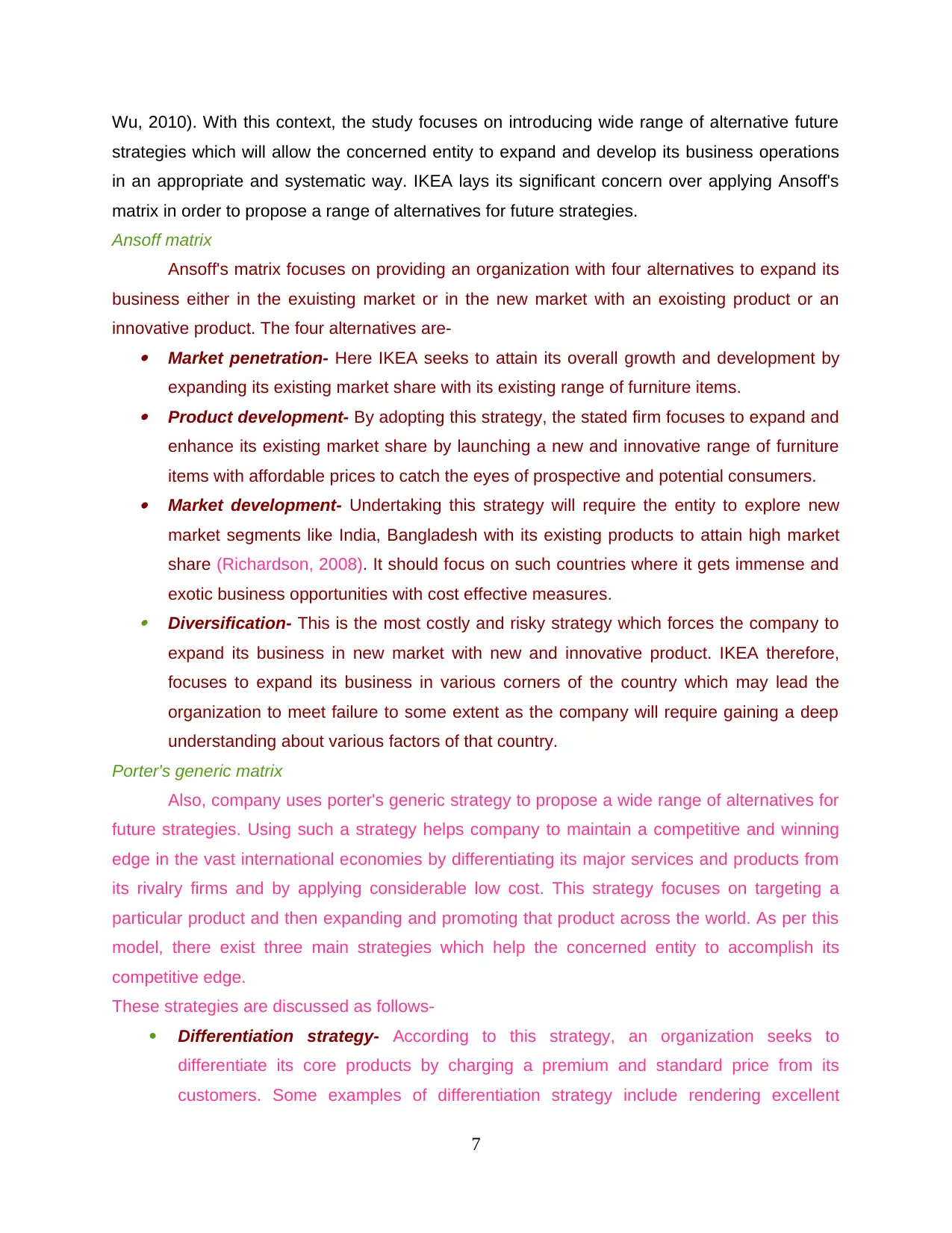
Wu, 2010). With this context, the study focuses on introducing wide range of alternative future
strategies which will allow the concerned entity to expand and develop its business operations
in an appropriate and systematic way. IKEA lays its significant concern over applying Ansoff's
matrix in order to propose a range of alternatives for future strategies.
Ansoff matrix
Ansoff's matrix focuses on providing an organization with four alternatives to expand its
business either in the exuisting market or in the new market with an exoisting product or an
innovative product. The four alternatives are- Market penetration- Here IKEA seeks to attain its overall growth and development by
expanding its existing market share with its existing range of furniture items. Product development- By adopting this strategy, the stated firm focuses to expand and
enhance its existing market share by launching a new and innovative range of furniture
items with affordable prices to catch the eyes of prospective and potential consumers. Market development- Undertaking this strategy will require the entity to explore new
market segments like India, Bangladesh with its existing products to attain high market
share (Richardson, 2008). It should focus on such countries where it gets immense and
exotic business opportunities with cost effective measures. Diversification- This is the most costly and risky strategy which forces the company to
expand its business in new market with new and innovative product. IKEA therefore,
focuses to expand its business in various corners of the country which may lead the
organization to meet failure to some extent as the company will require gaining a deep
understanding about various factors of that country.
Porter's generic matrix
Also, company uses porter's generic strategy to propose a wide range of alternatives for
future strategies. Using such a strategy helps company to maintain a competitive and winning
edge in the vast international economies by differentiating its major services and products from
its rivalry firms and by applying considerable low cost. This strategy focuses on targeting a
particular product and then expanding and promoting that product across the world. As per this
model, there exist three main strategies which help the concerned entity to accomplish its
competitive edge.
These strategies are discussed as follows-
Differentiation strategy- According to this strategy, an organization seeks to
differentiate its core products by charging a premium and standard price from its
customers. Some examples of differentiation strategy include rendering excellent
7
strategies which will allow the concerned entity to expand and develop its business operations
in an appropriate and systematic way. IKEA lays its significant concern over applying Ansoff's
matrix in order to propose a range of alternatives for future strategies.
Ansoff matrix
Ansoff's matrix focuses on providing an organization with four alternatives to expand its
business either in the exuisting market or in the new market with an exoisting product or an
innovative product. The four alternatives are- Market penetration- Here IKEA seeks to attain its overall growth and development by
expanding its existing market share with its existing range of furniture items. Product development- By adopting this strategy, the stated firm focuses to expand and
enhance its existing market share by launching a new and innovative range of furniture
items with affordable prices to catch the eyes of prospective and potential consumers. Market development- Undertaking this strategy will require the entity to explore new
market segments like India, Bangladesh with its existing products to attain high market
share (Richardson, 2008). It should focus on such countries where it gets immense and
exotic business opportunities with cost effective measures. Diversification- This is the most costly and risky strategy which forces the company to
expand its business in new market with new and innovative product. IKEA therefore,
focuses to expand its business in various corners of the country which may lead the
organization to meet failure to some extent as the company will require gaining a deep
understanding about various factors of that country.
Porter's generic matrix
Also, company uses porter's generic strategy to propose a wide range of alternatives for
future strategies. Using such a strategy helps company to maintain a competitive and winning
edge in the vast international economies by differentiating its major services and products from
its rivalry firms and by applying considerable low cost. This strategy focuses on targeting a
particular product and then expanding and promoting that product across the world. As per this
model, there exist three main strategies which help the concerned entity to accomplish its
competitive edge.
These strategies are discussed as follows-
Differentiation strategy- According to this strategy, an organization seeks to
differentiate its core products by charging a premium and standard price from its
customers. Some examples of differentiation strategy include rendering excellent
7
⊘ This is a preview!⊘
Do you want full access?
Subscribe today to unlock all pages.

Trusted by 1+ million students worldwide

services to its customers, outstanding performance of product etc. With this
perspective, IKEA should lay its concern over adopting differentiation strategy with the
simultaneous use of low-cost strategy. This will allow the company to render furniture at
low and affordable prices to its target niche market who posses high demand of good
quality furniture at reasonable prices. This strategy will force the said business group to
target its audience from among the upper middle class and middle class which were
not its core target market before. For further detail, see appendix 4.
Justifying the above strategies
The above strategies used by IKEA in order to plan for its future growth and expansion is
justifiable on the following grounds- Focus Differentiation strategy- The strategy is justifiable in the manner that it provides
the company to focus on its segmented and target market share rather than to the total
market. This benefits IKEA to maintain its overall cost of production and reduce its
expenses in adopting the techniques for its entire market proportion (Strategic
management, 2014). Furthermore, the strategy is justifiable because it helps the
company to impressively attain the needs and requirements of its target market in a
significant way thereby benefiting IKEA to gain immense market popularity. Promotion strategy- By undertaking such strategy, IKEA is able to retain its existing
customers thereby gaining the eyes of its new audience in an impressive and systematic
way. Also, such strategy will assist the organization to attain a winning and strategic
edge in the new international market thereby gaining an exotic global exposure in the
global recessionary market (Bharadwaj and et.al., 2013). In the present scenario of
globalisation and information technologies, the company should work on using
promotional strategy as it will assist IKEA to gain a huge crowd of masses thereby
resulting in acquiring a dominant and monopolistic market share in a significant and
appropriate way. Outsourcing/Off-shoring- This strategy helps the company to make the potential
benefit of low labour cost which results in reducing the overall cost of company's
production activities in a significant way (Grant, 2010). Furthermore, the strategy is
justifiable as it will allow IKEA to effectively explore the new market economies which will
result the company to make strategic advantage of the economies in an effective and
significant way.
8
perspective, IKEA should lay its concern over adopting differentiation strategy with the
simultaneous use of low-cost strategy. This will allow the company to render furniture at
low and affordable prices to its target niche market who posses high demand of good
quality furniture at reasonable prices. This strategy will force the said business group to
target its audience from among the upper middle class and middle class which were
not its core target market before. For further detail, see appendix 4.
Justifying the above strategies
The above strategies used by IKEA in order to plan for its future growth and expansion is
justifiable on the following grounds- Focus Differentiation strategy- The strategy is justifiable in the manner that it provides
the company to focus on its segmented and target market share rather than to the total
market. This benefits IKEA to maintain its overall cost of production and reduce its
expenses in adopting the techniques for its entire market proportion (Strategic
management, 2014). Furthermore, the strategy is justifiable because it helps the
company to impressively attain the needs and requirements of its target market in a
significant way thereby benefiting IKEA to gain immense market popularity. Promotion strategy- By undertaking such strategy, IKEA is able to retain its existing
customers thereby gaining the eyes of its new audience in an impressive and systematic
way. Also, such strategy will assist the organization to attain a winning and strategic
edge in the new international market thereby gaining an exotic global exposure in the
global recessionary market (Bharadwaj and et.al., 2013). In the present scenario of
globalisation and information technologies, the company should work on using
promotional strategy as it will assist IKEA to gain a huge crowd of masses thereby
resulting in acquiring a dominant and monopolistic market share in a significant and
appropriate way. Outsourcing/Off-shoring- This strategy helps the company to make the potential
benefit of low labour cost which results in reducing the overall cost of company's
production activities in a significant way (Grant, 2010). Furthermore, the strategy is
justifiable as it will allow IKEA to effectively explore the new market economies which will
result the company to make strategic advantage of the economies in an effective and
significant way.
8
Paraphrase This Document
Need a fresh take? Get an instant paraphrase of this document with our AI Paraphraser
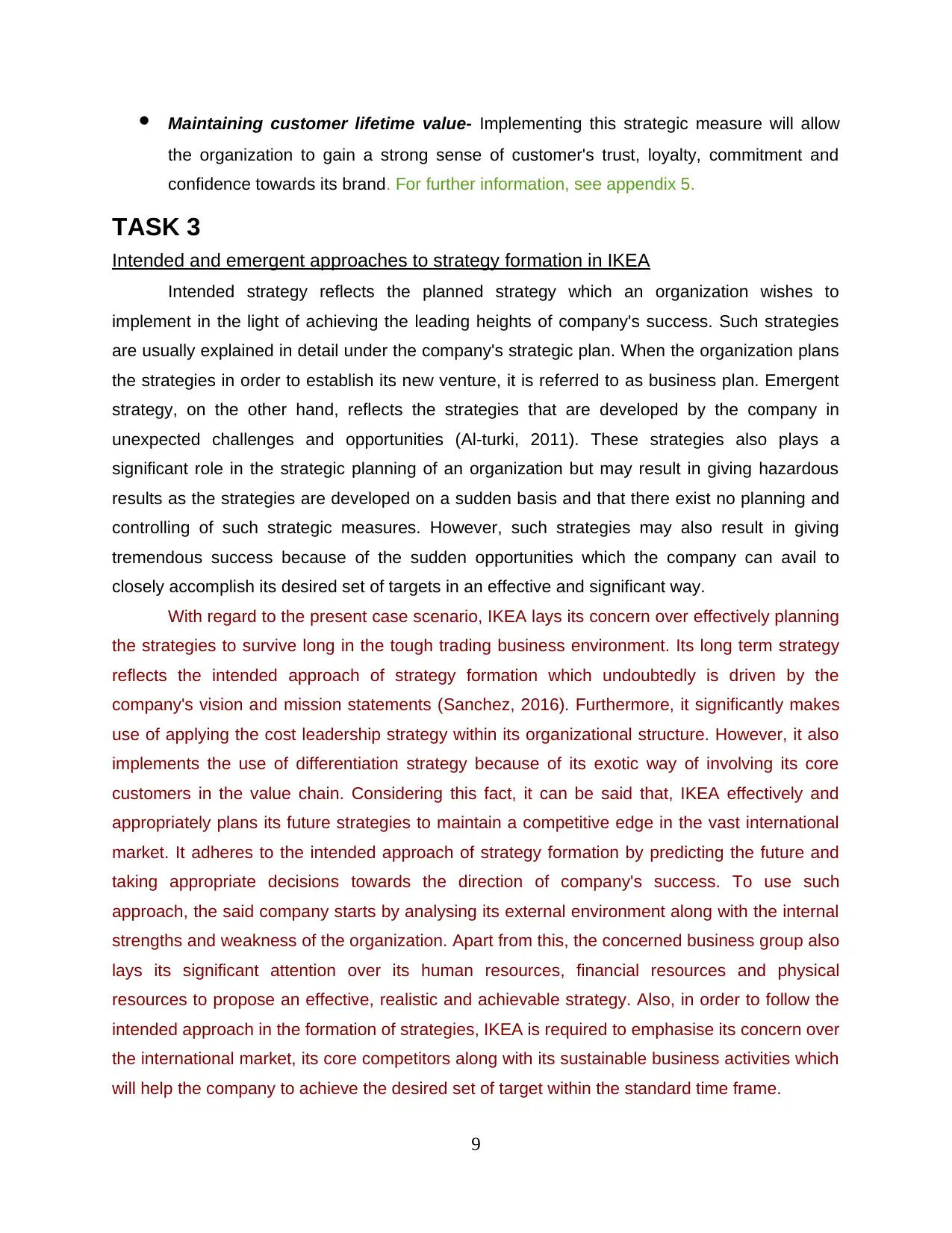
Maintaining customer lifetime value- Implementing this strategic measure will allow
the organization to gain a strong sense of customer's trust, loyalty, commitment and
confidence towards its brand. For further information, see appendix 5.
TASK 3
Intended and emergent approaches to strategy formation in IKEA
Intended strategy reflects the planned strategy which an organization wishes to
implement in the light of achieving the leading heights of company's success. Such strategies
are usually explained in detail under the company's strategic plan. When the organization plans
the strategies in order to establish its new venture, it is referred to as business plan. Emergent
strategy, on the other hand, reflects the strategies that are developed by the company in
unexpected challenges and opportunities (Al-turki, 2011). These strategies also plays a
significant role in the strategic planning of an organization but may result in giving hazardous
results as the strategies are developed on a sudden basis and that there exist no planning and
controlling of such strategic measures. However, such strategies may also result in giving
tremendous success because of the sudden opportunities which the company can avail to
closely accomplish its desired set of targets in an effective and significant way.
With regard to the present case scenario, IKEA lays its concern over effectively planning
the strategies to survive long in the tough trading business environment. Its long term strategy
reflects the intended approach of strategy formation which undoubtedly is driven by the
company's vision and mission statements (Sanchez, 2016). Furthermore, it significantly makes
use of applying the cost leadership strategy within its organizational structure. However, it also
implements the use of differentiation strategy because of its exotic way of involving its core
customers in the value chain. Considering this fact, it can be said that, IKEA effectively and
appropriately plans its future strategies to maintain a competitive edge in the vast international
market. It adheres to the intended approach of strategy formation by predicting the future and
taking appropriate decisions towards the direction of company's success. To use such
approach, the said company starts by analysing its external environment along with the internal
strengths and weakness of the organization. Apart from this, the concerned business group also
lays its significant attention over its human resources, financial resources and physical
resources to propose an effective, realistic and achievable strategy. Also, in order to follow the
intended approach in the formation of strategies, IKEA is required to emphasise its concern over
the international market, its core competitors along with its sustainable business activities which
will help the company to achieve the desired set of target within the standard time frame.
9
the organization to gain a strong sense of customer's trust, loyalty, commitment and
confidence towards its brand. For further information, see appendix 5.
TASK 3
Intended and emergent approaches to strategy formation in IKEA
Intended strategy reflects the planned strategy which an organization wishes to
implement in the light of achieving the leading heights of company's success. Such strategies
are usually explained in detail under the company's strategic plan. When the organization plans
the strategies in order to establish its new venture, it is referred to as business plan. Emergent
strategy, on the other hand, reflects the strategies that are developed by the company in
unexpected challenges and opportunities (Al-turki, 2011). These strategies also plays a
significant role in the strategic planning of an organization but may result in giving hazardous
results as the strategies are developed on a sudden basis and that there exist no planning and
controlling of such strategic measures. However, such strategies may also result in giving
tremendous success because of the sudden opportunities which the company can avail to
closely accomplish its desired set of targets in an effective and significant way.
With regard to the present case scenario, IKEA lays its concern over effectively planning
the strategies to survive long in the tough trading business environment. Its long term strategy
reflects the intended approach of strategy formation which undoubtedly is driven by the
company's vision and mission statements (Sanchez, 2016). Furthermore, it significantly makes
use of applying the cost leadership strategy within its organizational structure. However, it also
implements the use of differentiation strategy because of its exotic way of involving its core
customers in the value chain. Considering this fact, it can be said that, IKEA effectively and
appropriately plans its future strategies to maintain a competitive edge in the vast international
market. It adheres to the intended approach of strategy formation by predicting the future and
taking appropriate decisions towards the direction of company's success. To use such
approach, the said company starts by analysing its external environment along with the internal
strengths and weakness of the organization. Apart from this, the concerned business group also
lays its significant attention over its human resources, financial resources and physical
resources to propose an effective, realistic and achievable strategy. Also, in order to follow the
intended approach in the formation of strategies, IKEA is required to emphasise its concern over
the international market, its core competitors along with its sustainable business activities which
will help the company to achieve the desired set of target within the standard time frame.
9

Intended approach
Besides using intended approach, the cited firm should also focus on applying emergent
approach in the formation of its strategies (Strategic Management Journal, 2014). Using such
an approach will allow the organization to plan short term strategy to examine the customers
taste, preferences and habits in a significant way. Emergent approach of strategic formation is
more experimental and will require IKEA to develop short term tactics in the light of achieving
the company's success. This approach will serve the organization with a fascinating opportunity
to maintain its competitive edge in the vast global and corporate world. Also, it will allow the
company to impressively and effectively expand its business operations across the globe
thereby gaining the global exposure in tremendous manner.
Thus, from the above discussion it can be said, that IKEA is highly recommended
maintaining an appropriate balance between its intended and emergent approach in course of
formulating suitable strategies for its overall growth and development (Campbell, Edgar and
Stonehouse, 2011). This would benefit the firm to make the best and potential use of its
competencies which in turn will provide the concerned business to attain the success effectively.
CONCLUSION
From the above report, it can be concluded that IKEA effectively follows the crucial
aspect of strategic management in the light of gaining success and popularity. The report
helped to gain insight understanding about the strategic capabilities of IKEA along with its
alternative strategies for future growth and expansion. Also, the report focuses on
understanding the crucial aspects of intended and emergent approaches of strategic decision
making to attain the heights of success impressively. Furthermore, it has helped to gain deep
learning about company's internal capability by using value chain analysis and the external
capabilities by implementing porter's five force models. In addition, the report has also enabled
to acquire insight understanding about various ethical issues which IKEA is facing in the current
market economy. Furthermore, by making use of number of models, manager of firm can get
information about both external and internal environment. Thus, through this way, firm can make
effective decision which leads corporation to increased profit and sale.
10
Besides using intended approach, the cited firm should also focus on applying emergent
approach in the formation of its strategies (Strategic Management Journal, 2014). Using such
an approach will allow the organization to plan short term strategy to examine the customers
taste, preferences and habits in a significant way. Emergent approach of strategic formation is
more experimental and will require IKEA to develop short term tactics in the light of achieving
the company's success. This approach will serve the organization with a fascinating opportunity
to maintain its competitive edge in the vast global and corporate world. Also, it will allow the
company to impressively and effectively expand its business operations across the globe
thereby gaining the global exposure in tremendous manner.
Thus, from the above discussion it can be said, that IKEA is highly recommended
maintaining an appropriate balance between its intended and emergent approach in course of
formulating suitable strategies for its overall growth and development (Campbell, Edgar and
Stonehouse, 2011). This would benefit the firm to make the best and potential use of its
competencies which in turn will provide the concerned business to attain the success effectively.
CONCLUSION
From the above report, it can be concluded that IKEA effectively follows the crucial
aspect of strategic management in the light of gaining success and popularity. The report
helped to gain insight understanding about the strategic capabilities of IKEA along with its
alternative strategies for future growth and expansion. Also, the report focuses on
understanding the crucial aspects of intended and emergent approaches of strategic decision
making to attain the heights of success impressively. Furthermore, it has helped to gain deep
learning about company's internal capability by using value chain analysis and the external
capabilities by implementing porter's five force models. In addition, the report has also enabled
to acquire insight understanding about various ethical issues which IKEA is facing in the current
market economy. Furthermore, by making use of number of models, manager of firm can get
information about both external and internal environment. Thus, through this way, firm can make
effective decision which leads corporation to increased profit and sale.
10
⊘ This is a preview!⊘
Do you want full access?
Subscribe today to unlock all pages.

Trusted by 1+ million students worldwide
1 out of 18
Related Documents
Your All-in-One AI-Powered Toolkit for Academic Success.
+13062052269
info@desklib.com
Available 24*7 on WhatsApp / Email
![[object Object]](/_next/static/media/star-bottom.7253800d.svg)
Unlock your academic potential
Copyright © 2020–2025 A2Z Services. All Rights Reserved. Developed and managed by ZUCOL.





